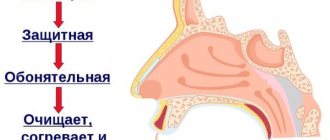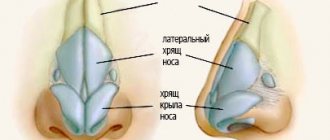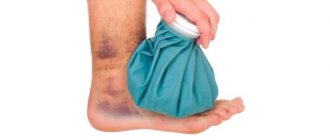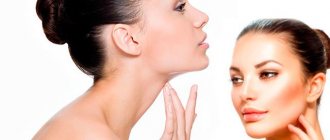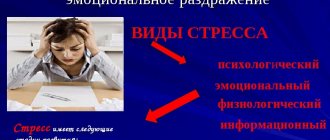- home
- Diseases
A hematoma of the nasal septum is characterized by the appearance of blood between the bone structures and cartilage as a result of vascular damage. In this case, nasal breathing worsens, the sense of smell is lost, and fluctuation appears in one or both halves of the nose.
As a result of a blow or bruise, a bruise forms on the face. The hematoma is not always visible externally, so victims may not seek medical help.
However, severe complications may occur due to the close location of the brain.
If the hematoma cavity is not emptied in a timely manner, after 3-6 days as a result of infection, suppuration of blood clots and an abscess of the nasal septum may develop.
Advanced cases cause septic lesions of the orbit and membranes of the brain (encephalitis, meningitis).
First aid
In the first minutes after the symptoms of a hematoma appear, it is necessary to apply a cold compress to the site of the bruise.
If this is not possible, use any cold objects, this will help relieve pain and reduce swelling.
To avoid hypothermia, do not use cold for more than thirty minutes.
A day after the injury, you can apply warm lotions or a hot heating pad two to three times a day for twenty minutes.
Heat causes capillaries to expand and blood moves away from the upper layers of the skin.
Doctors' advice
If a child has a rash on his chin, he needs more careful care. Recommendations for parents:
- There is no need to wrap your baby up if the room is warm. The air temperature should not exceed 22 degrees. During the heating season, it is recommended to install a humidifier in the baby's room.
- You need to bathe and wash your child daily. On hot days, water procedures can be carried out several times.
- After washing or bathing, the skin should be thoroughly blotted with a towel.
- A clean chin can only be lubricated with a cream based on dexpanthenol (“Bepanten”).
- Walk with your child outdoors as often as possible on clear days. Sunbathing often works better than any medicine.
- Maintain drinking regime. It is not advisable to offer tea to a child under 3 years of age. The ideal option is only clean and still water.
- In winter, protect your skin from cold and strong winds.
In addition, twice a year it is necessary to prevent helminthic infestations. This must be done in spring and autumn for all family members. Parents can take any broad-spectrum drug in tablet form. For children, the suspensions “Nemozol” and “Pyrantel” are most often prescribed. They have a pleasant sweet taste, so the baby accepts them calmly. The dosage regimen is determined by the doctor.
Treatment
The appearance of a hematoma on the face may indicate a traumatic brain injury and hematoma, or bone fractures.
To exclude such complications, you should consult a doctor for advice.
If first aid was not provided, or the hemorrhage turned out to be severe enough, drug treatment is carried out.
The doctor administers blood-absorbing drugs intramuscularly. You can also use heparin-based ointments and homeopathic remedies.
Another method of treating hematoma on the face is physical therapy. It is aimed at reducing swelling, relieving pain and resolving hemorrhage.
To do this, apply alcohol compresses, cryotherapy (cold, liquid nitrogen) and ultraphonophoresis.
Ways to deal with bruises
Both pharmaceutical products and many traditional medicine recipes will help eliminate such an unpleasant problem. But before you raise the question of how to remove a bruise on your face, you should think about the true reasons for this phenomenon. The simplest option is when a dark spot appears due to mechanical impact. But if a bruise occurs for no apparent reason, it is worth contacting a specialist to exclude or diagnose a pathology that may manifest itself in this way.
If you suspect any disease, you need to stop self-medication and carry out timely diagnosis to prevent it from developing into a more severe form. Only the necessary therapeutic methods will eliminate the pathology and consequently prevent the occurrence of abrasions.
What can you do yourself?
You should use any medications only as prescribed by a specialist. You can adjust your diet yourself. Diversify your daily menu with foods rich in vitamins, especially P and C. These include bananas, herbs, rosehip infusions, cucumbers, salads, citrus fruits, black currants.
If you associate the appearance of bruises with taking medications, stop using them and consult your doctor.
What to do if the hematoma does not go away?
A large number of vessels and fatty tissue in the form of a thick and loose layer located on the face can cause the appearance of large hematomas.
Sometimes the hematoma can spread to the scalp, neck and even chest.
Large hematomas take a very long time to resolve and may be accompanied by suppuration, which will subsequently lead to sepsis.
In such situations, the doctor performs a puncture - inserts a needle into the hematoma cavity and sucks out the fluid.
If suppuration begins, the source of infection is removed surgically. Then drainage is installed and antibiotics are prescribed.
In some cases, when the hematoma does not resolve for a long time, a repeat puncture with the administration of penicillin is required.
The patient experiences general malaise and fever. Often an infection is added to the inflammation, for example, due to diseased teeth.
A high temperature is a sign of an abscess, which may be accompanied by suppuration. The doctor cuts the hematoma and removes its contents.
Thrombocytopathies
Thrombocytopathies are a condition where platelets are defective and do not function properly. About 36% of this group is hereditary. In addition to hereditary forms, acquired forms are quite common.
Hereditary forms include:
- Glanzmann's thrombasthenia;
- von Willebrand disease;
- 3 platelet abnormalities and dysfunctions.
We suggest you read: Tattoo itches after a year - About itching
Acquired platelet defects:
- hemoblastosis - tumor diseases of hematopoietic and lymphatic tissue;
- myeloproliferative diseases;
- B12 - deficiency anemia - deficiency of vitamin B12;
- liver cirrhosis, liver tumors, parasitic liver lesions;
- DIC syndrome;
- paraproteinoses (myeloma, Waldenström's disease) - disorders of protein metabolism with deposition of paraproteins in tissues;
- scurvy - a condition caused by an acute deficiency of vitamin C;
- hormonal disorders (hypothyroidism, hypoestrogenism);
- medications and toxic substances (aspirin, beta blockers, pyrazolone derivatives);
- radiation sickness;
- blood transfusions - blood transfusions;
- major thrombosis - the formation of blood clots in the lumen of blood vessels or in the cavities of the heart;
- giant angiomas are tumors from blood vessels.
A characteristic sign of a violation of the life and function of platelets is a normal number of platelets, but at the same time the patient has manifestations in the form of various hemorrhages. Also, the blood coagulation system was normal during examination.
How does it manifest? This group of diseases as a whole usually manifests itself as petechial-bruising types of hemorrhages. Petechiae and bruises occur on the skin and mucous membranes, causing nosebleeds and uterine bleeding. In hereditary forms of thrombocytopathies, bruising occurs more often. Hemorrhages appear quickly with physical impact, for example, pressing on the skin, squeezing the arm with a tonometer cuff, as well as at injection sites.
Ointments for hematomas
Used to treat bruises with bruises and abrasions. External hematomas are treated with simple medicinal ointments and solutions for their speedy recovery.
If after an injury the victim feels pain and discomfort, then it is necessary to use an ointment with an analgesic effect.
Ointments for hematomas and bruises
Express bruise – created on the basis of badyagi extract, used for bruises and age spots.
If the cream is applied immediately after a bruise, a bruise will not appear at all.
If this is done after a few hours, the bruise will resolve within two days.
If you use the cream every other day, everything will go away in three days. Sinyak-off is a gel containing pentoxifylline, ethoxydiglycol, BOA, TEA and leech extract.
Helps accelerate the resorption of bruises and the disappearance of bruises, reduces swelling. It has contraindications for hemophilia (blood clotting disorder).
Indovazin is a gel based on indomethacin and troxerutin.
Indomethacin has an analgesic and anti-inflammatory effect, relieves pain, swelling and redness.
Troxerutin strengthens the vascular wall, improves microcirculation, reduces fragility and permeability of capillaries.
Contraindicated in hemophilia (blood clotting disorder), ulcerative lesions of the gastrointestinal tract, children under fourteen years of age and pregnant women.
Remedies for bruises based on Arnica
Arnica is a perennial medicinal plant that grows in the mountains.
Ointments based on it have anti-inflammatory, analgesic, regenerating and antibacterial effects.
Used for resorption of subcutaneous hematomas and bruises, muscle pain, abrasions, sprains, bruises.
Contraindications : during pregnancy, during lactation, with violations of the integrity of the skin, children under 18 years of age, with hypersensitivity, allergies. With prolonged use, blistering dermatitis may occur.
Heparin ointment
It is effective against bruises and contusions, since it contains not only heparin (which has an antithrombic effect), but also benzyl ester of nicotinic acid, which dilates blood vessels.
It also helps improve the absorption of heparin.
Benzocaine has an analgesic effect.
Heparin-based products are used for treatment from 5 to 15 days.
Contraindications: open wounds, ulcerative-necrotic processes, venous thrombosis, hypersensitivity.
Do not use simultaneously with antihistamines, NSAIDs and tetracyclines.
Allergic reactions may occur.
Troxevasin
It is made on the basis of troxerutin, which has anti-inflammatory properties, relieves swelling, and reduces capillary fragility.
Contraindications: hypersensitivity, allergic reactions (symptoms of dermatitis, urticaria).
Badyaga
Products based on this unique natural component have excellent absorption properties.
Badyaga is a freshwater sponge. Its skeleton consists of silica needles, which are interconnected by organic matter.
The effect of ointment with badyaga is to irritate areas of the skin with silicon needles.
This action leads to vasodilation and increased blood supply.
After applying the gel, the skin turns a little red and a slight warming effect occurs.
Use is indicated for age spots, acne, bruises, bruises, arthritis, rheumatism.
Contraindications: for open wounds, with intolerance to the constituent components.
To determine intolerance, you need to apply the product to the crook of your elbow and evaluate the skin reaction.
Possible reasons for the appearance
A bruise on the nose is popularly called simply cream, most likely due to its external similarity to this fruit. The mechanism of formation of a plum on the nose is very simple. The main initiating factor is tissue damage:
- bruises;
- squeezing;
- frostbite.
It is also worth paying attention to the fact that even the simplest squeezing of pimples or a harmless hickey made by a partner can turn your nose blue. Other factors that contribute to nose bruising are:
- pale and tender skin;
- the vessels are too close to the surface of the skin;
- existing defects in the blood coagulation system.
With mechanical damage, traumatization of small capillaries, which have increased vascular permeability, is observed. Formed elements of blood pass into nearby tissues, first of all, red blood cells. As a result, a small subcutaneous hematoma is formed, after which the red cells begin to break down and release a pigment called hemoglobin. For this reason, the nose acquires a purple tint. After this, hemoglobin is formed into other substances, which is why the nose becomes bluish, lilac-cherry or yellow-green.
Folk remedies
The use of traditional medicine occurs only for small hematomas.
In other cases, consultation with a qualified specialist is necessary.
Cabbage compress
To make this compress you will need several leaves of fresh cabbage.
They need to be finely chopped so that the cabbage gives juice, and wrapped in gauze.
Apply the finished compress to the hematoma until it completely resolves.
Potato compress
This compress is also easy to prepare.
You will need to grate raw peeled potatoes on a fine grater and wrap them in cheesecloth.
The finished compress is applied to the hematoma overnight.
The procedure is carried out until the hematoma is completely resolved.
Cabbage and potato juice are good at relieving swelling and eliminating the inflammatory process. It is also recommended to use flower honey, it has a soothing and absorbable effect.
When using these recipes, do not forget to monitor changes in the hematoma. If her condition noticeably worsens, you should immediately consult a doctor.
How to draw a bruise on the face?
If the products you used did not help remove the bruise in 1 day, and you need to go to an important meeting, cover it with concealer. In the form of a cream, this product is suitable for masking a bruise under the eye, and in the area of the cheeks, chin, and forehead it is better to use a stick. Also consider its shade and the color of the abrasion.
Yellow concealer is used for purple bruises on the face, blue for red ones, and orange for covering greenish spots. After treating the heel with concealer, apply makeup base, foundation, or just powder.
A bruise on the face is an unpleasant phenomenon, but before you eliminate it, try to find out the cause of its occurrence in order to promptly identify possible diseases that can trigger its appearance.
Other groups of hemorrhagic diathesis
In the practice of a doctor, there are other unusual forms of hemorrhagic diathesis. These forms include:
- Psychogenic hemorrhagic diathesis.
- Hysterical imitations of hemorrhagic diathesis. To attract attention, patients imitate hemorrhages, for example, by pinching and sucking bruises, injuring mucous membranes, and even taking medications (anticoagulants). Treatment of such patients is carried out jointly by a therapist and a psychiatrist.
- Mild bruising, which does not require any special therapy, may be associated with hormonal imbalances. It often occurs in girls during puberty and persists until the first birth, sometimes reappearing during menopause. At the same time, no violations are detected in the hemostatic system.
- Children's. In some cases, hemorrhages in children are not a sign of hemorrhagic diathesis. The appearance of bruises is associated with trauma, such as blows from toys, bites, and pinches. Children often hide the cause of bruises. Therefore, parents need to monitor their children and find out the reasons for their occurrence.
Thrombocytopenia
Thrombocytopenia is a condition characterized by a decrease in the number of platelets. Typically, a decrease in platelet counts occurs throughout life. Causes: immune processes, mechanical trauma to platelets (surgeries, tumor processes), chemical and radiation damage to the bone marrow (platelets are formed here), replacement of bone marrow with tumor tissue, increased consumption of platelets (thrombosis, disseminated intravascular coagulation syndrome), mutations (Marchiaf-Michelli disease ).
The most striking representative of this group is Werlhof's disease (idiopathic thrombocytopenic purpura). How does it manifest? The disease is characterized by the appearance of asymmetrical hemorrhages (petechial-spotted type) in the skin (usually on the limbs and anterior surface of the body due to greater trauma), mucous membranes (conjunctiva, oral and nasal mucosa) and bleeding of the gastrointestinal tract, kidneys (blood in the urine ). Very often, hemorrhages occur at injection sites. It is typical for hemorrhages to occur spontaneously, including at night. Thrombocytopenia differs in that with injuries, as a rule, bleeding that is inadequate to the damage (much more severe) develops.
Very important! Hemorrhages can also be localized in the brain. They are usually preceded by the appearance of bloody patches on the face or neck. Severe bleeding, as a rule, develops against the background of hemorrhages on the skin (cutaneous hemorrhagic syndrome).


